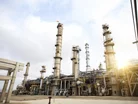The impact of inflation, energy costs & tax on manufacturing

2022 was an unforgettably tumultuous year, providing the manufacturing industry with several challenges, and, while ONS data revisions have shown that the post-pandemic recovery of the sector was stronger than initially thought, the UK’s industrial production has been declining steadily since the middle of 2021.
The weakness witnessed last year resulted in an estimated 2.5% decline, and it is expected that we will see a further contraction of over 2% in 2023. The combined impacts of inflation, energy costs and tax policy all weighed on the industry, but just how heavily will these factors continue to be a threat over the year ahead, and are there any mitigating factors?
Tax on machinery and equipment
While the ‘super deduction’ tax on qualifying machinery and equipment has been relatively successful in spurring investment in machinery, this has pulled forward capex investment rather than fundamentally changing underlying demand. We expect subdued growth prospects, rising costs, and the substantial increase in debt taken on by service sector firms during the pandemic to limit growth in 2023. Moreover, the expiry of this tax deduction will likely lead to a temporary pullback on capital and equipment spending. We expect that it will take a further five years for business investment to return to its pre-pandemic level.
On a sectoral level, production of capital goods such as machinery and fabricated metal products are expected to retreat in 2023. This will further limit demand for upstream goods such as metals, already hit by high energy prices.
Jeremy Leonard, Managing Director, Global Industry Services at Oxford Economics
Energy costs hit manufacturers
A second factor weighing on the manufacturing industry has been the sharp increase in natural gas costs which pushed up inflation and costs for manufacturers. Electricity wholesale prices have also risen steeply. Gas accounts for about 40% of UK electricity generation and is normally the marginal source of generation which usually sets the wholesale price of electricity, meaning gas price spikes have disproportionately impacted electricity prices. With the loss of Russian gas expected to continue for the indefinite future, these costs are likely to remain elevated over the course of 2023 and both electricity and gas output are only expected to return to modest growth.
Chemicals, refining, metals, and building materials look most heavily exposed to previous rising gas prices. All these sectors are expected to post considerable declines in 2023 as a result. Chemicals output, in particular, was estimated to have declined nearly 4% in 2022 and will likely shrink a further 6% this year.
This impact comes despite the government’s price cap limiting demand destruction for the sector over the winter, but prices are still about double what they were just over a year ago. Recent gas price declines may signal a crisis averted, but the ongoing impact weighing on the manufacturing sector remains substantial.
Inflation’s impact on the manufacturing sector
Rising energy costs are a big part of the cost-of-living crisis, contributing to inflation peaking at 11.1% in October 2022, a 41-year high. We expect it to average 7.6% for 2023. We estimated real household incomes to have fallen by more than 4% between the Q1 2021 peak and its expected trough of Q4 2022. Households may be able to cushion the blow by taking on new credit and spending a portion of excess savings accumulated during the coronavirus pandemic, but an already low savings rate means that scope is rather limited.
This trend – a steep decline in real household incomes, as well as rising borrowing costs – is weighing on consumer spending. With the economy moving into recession, the usual suspects of big-ticket discretionary consumer products such as white goods and household furnishings are expected to weaken. Automotive production will be a notable exception because, despite the weakness in current demand, automakers are busy working through backlogs built up during the semiconductor shortages over the past 18 months.
And of course, the monetary policy outlook remains uncertain following the negative market reaction to the government’s ‘mini-budget’ in September. While it’s encouraging that the anticipated recession is now predicted to be both shorter and less severe than previously expected, the full impact on the manufacturing sector as a whole is yet to play out given the varying effect on building and infrastructure, chemicals and construction.
It is clear that the industry is faced with acute challenges that, amid a wider economic downturn, are threatening future prosperity. High inflation and energy costs aren’t set to disappear any time soon and the turbulence of 2022 will likely have ongoing impacts well into 2023, although initial fears around a looming recession are seemingly not as deep as first predicted. The challenge remains for manufacturing firms to mitigate the threat of these external factors over the course of the next 12 months and weather the storm of uncertainty.
- Digitalisation as a Strategy to Attract and Retain WorkersDigital Factory
- UPDATED VENUE & DATE – Manufacturing LIVE Chicago 2025Sustainability & ESG
- ABB Cuts Industrial E-Waste in Quest for CircularitySustainability & ESG
- Why Are Manufacturers Doubling Down On Digital Twins?Digital Factory

